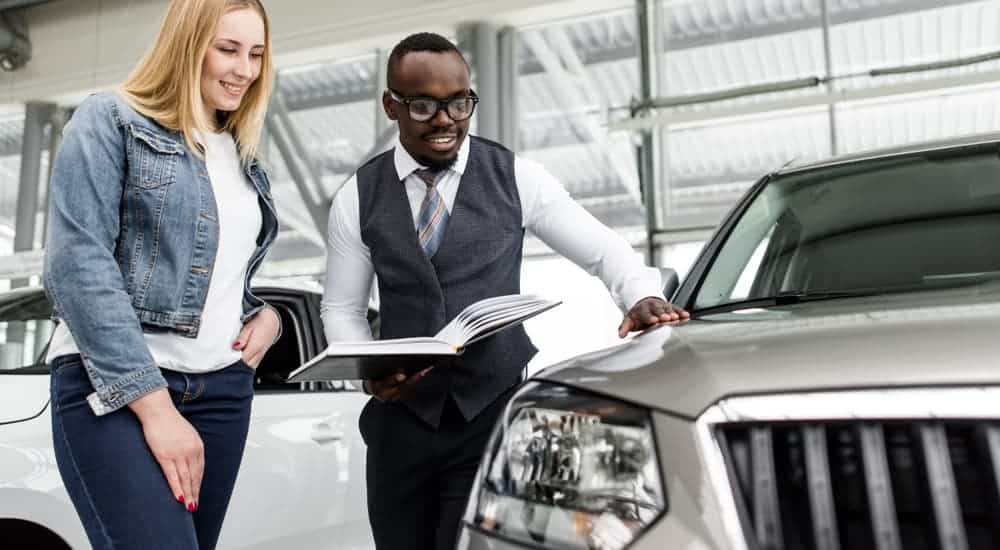Have you ever walked into a dealership and gotten the feeling that all the salespeople are in on a secret, and you have no idea how to crack the code? You visit your local car dealership, hoping they won’t notice you skulking between the cars while you cup your hands to see the interior, doing everything you can to avoid having to interact because you know they will yank out all the jargon you don’t understand. Some car dealerships are infamous for using car sales terminology as a means of confusing customers, but you don’t have to let that keep you from getting a great deal on the exact car you want.
Rather than visiting the lots after the salespeople go home or dodging them in the parking lot, you can learn their lingo and speak it like a pro. It’s empowering, like when you have to take your car to the shop, and you know the difference between the muffler and the exhaust manifold so the mechanic can’t talk you into service your car doesn’t need. Learning the language of car dealerships may help save you money and give you confidence when you head out to the local dealership for your next vehicle purchase. Below, you will find several questions that answer what many typical terms mean.
What Exactly Is MSRP?
It stands for Manufacturer’s Suggested Retail Price, the lowest price a dealership is expected to charge for selling a new vehicle. You will see this suggested price listed on the sticker dealerships often place on vehicle windows.
How Do I Know If I Need an Extended Warranty or Service Contract?
A warranty and a service contract are basically the same things. Typically they are sold by dealerships as a means to supply extra coverage above or beyond what the manufacturer already provides when you buy a vehicle. Most manufacturers cover the expenditure of things that could go wrong as a result of mistakes or low-quality work on new vehicles, and most vehicles don’t need more than the warranty offers in the first few years.

What Is a Conveyance Fee?
A conveyance means most directly that it is a way to help move something. Your dealership is the middle man between you and the manufacturer, and the dealership’s job is to “move” the cars from the factory to the buyer. As the movers, the dealerships can have fees within the purchasing price in order to assure that they make money on the deal. With that said, dealerships don’t often make as much on their new vehicles as most people think. New cars only make up about 26% of a dealership’s profits, so they might include extended warranties and add conveyance fees.
Why Do I Need to Pay a Dealer Handling or Service Fee?
Much like the conveyance fee, this is another means for the dealership to make money. In one sense, this is part of the process dealerships use to ensure they make back what they pay for each vehicle they sell, and then also pay the price of having salespeople and other employees to help you find the car you want to buy. All the employee time and effort costs the dealership time and money, and they have to find ways to offset those costs. This can be seen as sneaky from the buyer perspective, but the dealership needs profits in order to operate.
What Is the Difference Between Make and Model?
The make of a car is the manufacturer who built or “made” your vehicle. When referring to the model, it’s the style of car you buy from that manufacturer. For instance, you may prefer to purchase Toyota vehicles, which is the make, and you decide you want to buy a Prius, which is the model.
What Does Trim Mean?
Taking the terminology of make and model a little deeper, the trim level refers to an even more specific style of model. You may want a Toyota Prius, and you learned you can have it with a sunroof. That will determine which trim level you choose, which would be the Limited, in order to have that sunroof. It’s typical to see the trim level—particularly for the more expensive trims—to be on a badge on the vehicle. Locations vary, but they can be found on dashboards, the trunk, or on the front side of a vehicle. Basically, it boils down to what features you gain for the price you pay, and most vehicles sold today have several trim levels to offer different sets of desirable features, with the base trim being the lowest-priced.
Is Selling Price the Same as Suggested Retail Price?
In a phrase, pretty much. The selling price could also be exchanged with the sticker price, asking price, or MSRP, which is essentially a number the dealership hopes you pay. You always have wiggle room to haggle that number down by thousands, no matter how often your sales rep says he or she needs to talk to their manager.
What Is a Dealer Invoice?
This is what your local car dealership had to pay for the car you want to buy. From this base point, the dealership marks up the price in order to make money on the vehicles they sell.
What Does F&I stand for?

When you hear the salespeople saying this, they are referring to Finance and Insurance. While this part of a dealership handles the money and paperwork side of the purchase, be wary of their sales insertions. They may want to sell you on extras like those warranties or service contracts described earlier, or to offer a loan through a lender with higher fees than you might pay with a lender you find on your own. Don’t assume this will happen, however. Honest dealerships do exist, and there are helpful people who provide excellent information about the buying process and what you actually need to protect your investment.
Annual Percentage Rate (or APR): When you borrow money, the lender charges you a percentage of what you owe. This charge is applied as an annual, or yearly, rate to which you agree when you sign the paperwork. Your APR should be listed when you read and sign the papers to borrow from any lender, and lower rates are always what you want to seek.
What Is a Buyer’s Order?
This is the stack of papers you need to sign when you buy your car, and is your binding contract to seal the sale. Beyond just an agreement, it is an itemized list of everything that car has in terms of its make, model, trim, warranty, added options, taxes applied, fees added, and even the VIN number. Absolutely every bit of money to be exchanged should be itemized, as should every single feature of the vehicle you purchase, along with every single warranty or contractual obligation which binds the dealership and manufacturer to honor your purchase agreement. This is a legally binding contract, so this is very important to go over with care.
What Are Up-Front Costs?
When you are ready to buy your vehicle, you usually need to supply a down payment, which amounts to a certain agreed-upon percentage of the overall price of the car. Rarely, you might find a dealership offering specials for no down payments and no fees for a certain amount of time or for specific vehicles, but this is typically reserved for people with already good credit. Most people need to provide a down payment and have to agree to paying any fees associated with the deal (the conveyance fee, handling fee, etc. listed on the buyer’s order), and they must be paid upon signing the contract or buyer’s order.
Now that you have a decent set of terminology to use when you go out looking for your next vehicle, you are ready to manage some of the most important aspects of purchasing a new car with confidence. Always remember, however, that if you don’t understand the terms being used, you should always ask for clarification. A good dealership may use hard to understand terms but is more than happy to break it all down for you.



